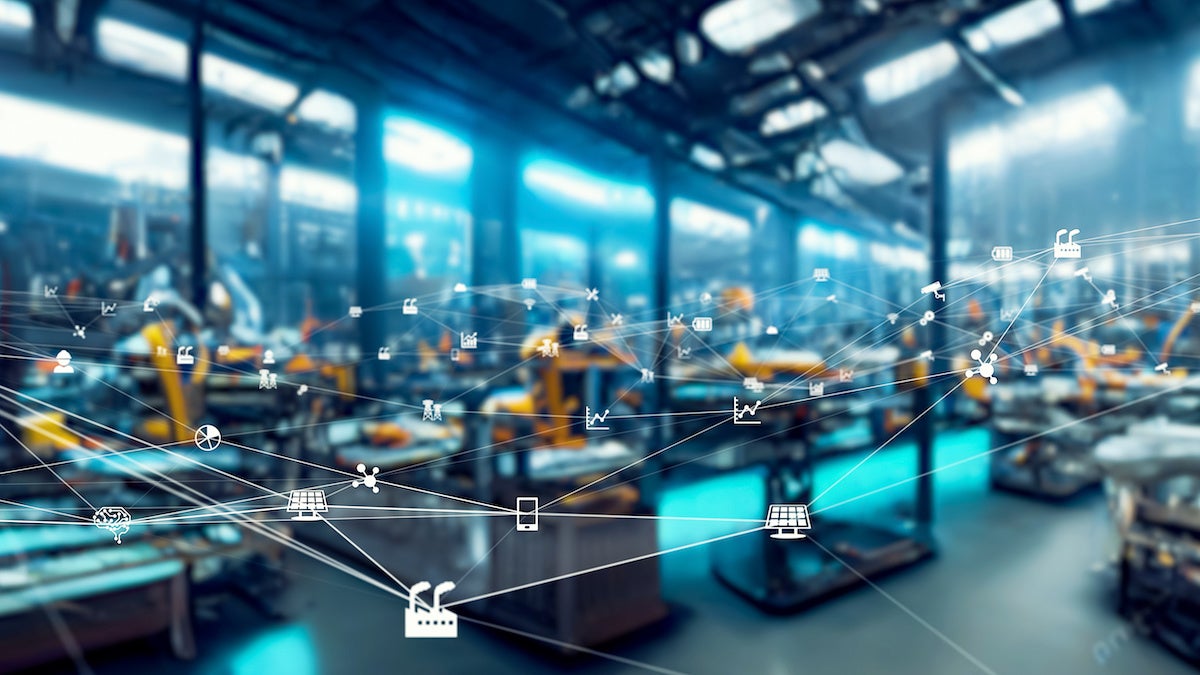With the rise of automation technology, manufacturing has reached a new level of efficiency. Robotics, the Internet of Things (IoT), and advanced software have made it possible for innovative manufacturers to transform their facilities into “smart factories.” These factories use data exchange, automation, and software to create a highly efficient and agile production environment.
What Is a Smart Factory?
Smart factories are deeply interconnected intelligence hubs that enable fluid communication and collaboration between machines, devices, and systems. With this interconnected ecosystem, manufacturers can optimize operations and gain real-time insights, driving continuous improvement throughout the entire production lifecycle.
Smart factories represent a significant example of digital transformation in manufacturing, enhancing key aspects of the production process.
How Does a Smart Factory Work?
A smart factory integrates data-driven processes, advanced technologies, and automation. These integrations allow for a highly efficient manufacturing environment. Here is how a smart factory typically works:
- Collecting Sensor Data: Smart factories collect real-time data from a network of IoT sensors embedded in machinery and equipment, enabling predictive maintenance, data processing, and analysis.
- Enabling Predictive Maintenance: Smart factories predict potential equipment failures before they occur, allowing for timely maintenance that minimizes downtime.
- Connecting and Processing Data: Manufacturers use IoT solutions to integrate, process, and analyze data to reach their goals.
- Customizing Solutions: Smart factories can also tailor production processes based on real-time data insights, allowing for efficient customization of products to meet diverse market demands and customer preferences.
- Integrating Supply Chain Analytics: By integrating supply chain analytics, smart factories optimize the flow of materials to improve efficiency and create a synchronized, responsive production ecosystem.
What Technologies are used in Smart Manufacturing?
Smart manufacturing involves the integration of advanced technologies to optimize production processes and improve efficiency. Various technologies contribute to the optimization of smart manufacturing, including:
Industrial Internet of Things (IIoT)
IoT connects machines, devices, and systems through a network of sensors that collect real-time data on production lines, equipment performance, and environmental conditions.
Artificial Intelligence (AI) and Machine Learning (ML)
I and ML algorithms analyze historical and real-time data to predict production trends, quality issues, or equipment failures, helping manufacturers optimize processes.
Cloud Computing
The cloud allows manufacturers to store and process large volumes of data generated from production systems, providing flexibility, scalability, and cost savings.
What Are the 5 Main Elements of Smart Manufacturing?
While smart manufacturing has numerous interconnected parts, there are five foundational elements to an efficient, well-run smart factory.
- EDI Modernization: This upgrades traditional data exchange to more advanced, automated processes. This improves communication, collaboration, and visibility across the supply chain.
- Data Integration: Merging diverse data sources facilitates a holistic view of operations. It enables better decision-making by consolidating information from various stages of the production process. Boomi and Alleantia partner to deliver the most complete system for processing IoT data for manufacturers.
- Data Analysis: IoT sensors produce huge datasets that require advanced analytics tools to derive valuable insights that enhance operational efficiency.
- Visualization and Scalability: Complex IoT data produced by smart factories must be processed for use and growth. Visualization entails presenting data in an understandable way. Scalability ensures the system can adapt and expand to accommodate growing data volumes and changing operational needs.
- User Experience (UX): Smart manufacturing UX focuses on creating intuitive interfaces and workflows that empower users to interact efficiently with the technology. This prompts user adoption, reduces training times, and maximizes smart manufacturing benefits.
What Are the Benefits of a Smart Factory?
Implementing a smart factory offers many benefits that can significantly enhance a manufacturing operation’s efficiency, productivity, and competitiveness. Here are some of the key advantages for companies can take advantage of.
- Increased Operational Efficiency: Smart factories leverage automation and real-time data insights to reduce downtime and optimize resource utilization. This increases overall efficiency.
- Reduced Costs: Predictive maintenance and better data-driven decision-making reduce operational costs, energy consumption, and waste.
- Improved Quality Control: Advanced sensors and analytics ensure precise monitoring of production processes, leading to enhanced product quality.
- Better Competitive Advantage: By embracing cutting-edge technologies and agile production methods, smart factories gain a competitive edge. This comes from faster time-to-market, increased customization capabilities, and swifter adaptation to market demands.
- Heightened Compliance: Real-time monitoring and traceability features enable manufacturers to meet evolving compliance standards and regulations.
- Optimized Operations: Smart factories foster a culture of continuous improvement. The information from data analytics allows manufacturers to immediately identify bottlenecks, inefficiencies, and opportunities for optimization.
What Is the Future of Smart Factories?
Overall, smart factories represent a significant digital transformation in manufacturing, ushering in a new era of agile, adaptive, and smart production lines. This transformative journey is marked by the seamless integration of cutting-edge technologies, including artificial intelligence, 5G connectivity, augmented reality, and automated EDI processing. These new technologies and enhanced integration ensure faster, more accurate manufacturing processes.
As manufacturers navigate this digital frontier, the interplay of these technologies promises to redefine industry standards, paving the way for a new era of manufacturing excellence. Manufacturers can expect a seamless convergence of physical and digital realms.
Modernize Your Factory With Boomi
The smart factory is the future of manufacturing. The insights and data analysis provided by IoT connections and sensors give manufacturers the competitive edge they need for today’s lightning-fast economy.
To take full advantage of a smart factory, you need an integration solution that connects data, people, and processes. Having the data isn’t enough – you need to be able to use it. Boomi is the best solution to optimize your value streams and gain that competitive edge.
Explore Boomi’s intelligent integration and automation capabilities — watch our platform demo today.

 English
English 日本語
日本語